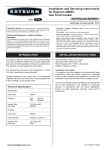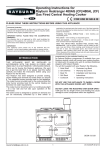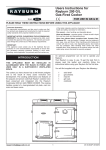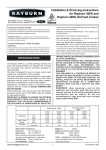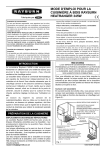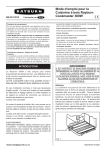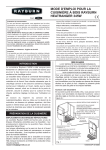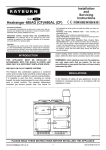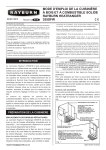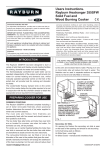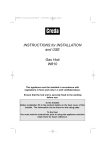Download Rayburn 200G/L Gas Fired Cooker Operating instructions
Transcript
Installation and Servicing Instructions for Rayburn 200G/L Gas Fired Cooker FOR USE IN GB & IE PLEASE READ THESE INSTRUCTIONS BEFORE INSTALLING THE APPLIANCE Consumer Protection As responsible manufacturers we take care to make sure that our products are designed and constructed to meet the required safety standards when properly installed and used. below for information. Firebricks – when handling use disposable gloves. Fire cement – when handling use disposable gloves. Glues and sealants – exercise caution – if these are still in liquid form use face mask and disposable gloves. IMPORTANT NOTICE: PLEASE READ THE ACCOMPANYING WARRANTY. Any alteration that is not approved by AGA, could invalidate the approval of the appliance, the warranty and could also infringe the current issue of the statutory requirements. Glass Yarn, Mineral Wool, Insulation Pads, Ceramic Fibre, Kerosene Oil – may be harmful if inhaled, may be irritating to skin, eyes, nose and throat. When handling avoid inhaling and contact with skin or eyes. Use disposable gloves, face masks and eye protection. After handling wash hands and other exposed parts. When disposing of the product reduce dust with water spray, ensure that parts are securely wrapped. IMPORTANT: This appliance could contain any of the materials that are indicated below. It is the Users/Installers responsibility to ensure that the necessary personal protective clothing is worn when handling, where applicable, the pertinent parts that contain any of the listed materials that could be interpreted as being injurious to health and safety, see INTRODUCTION INSTALLATION INSTRUCTIONS THIS APPLIANCE MUST BE INSTALLED IN ACCORDANCE WITH THE RULES IN FORCE AND USED ONLY IN A SUFFICIENTLY VENTILATED SPACE. Gas connection 15mm O.D. copper. Open flue outlet 100mm min. Electric Supply 50Hz 3 amp fused 230V. Weight of Appliance 275Kg. The Rayburn 200G/L Gas-Fired Cooker provides cooking facilities only. A single atmospheric gas burner is thermostatically controlled at cooking rates, and operates at a low bypass rate when idling. The exhaust flue connection of the appliance is in Open Flue form, operating on natural draught. Facilities included on the cooker are, a heat graduated hotplate, main oven and lower oven. A timing programmer is also available, as an optional extra. In your own interests, and that of safety, all gas appliances should be installed by competent persons, in accordance with the regulations in force. Appliance The appliance must be installed on a solid level floor or base of incombustible material which is capable of supporting the total weight. Location The location chosen for the appliance must permit installation and the provision of a satisfactory flue and an adequate space for servicing and air circulation around the appliance. See Section - Installation of Appliance General. Technical Specification Natural Gas Heat Input 5.6kW Pressure G20 G25 Injector Size Pilot Size 1.82 Bray 460 38/36A REMEMBER, when replacing a part on this appliance, use only spare parts that you can be assured conform to the safety and performance specification that we require. Do not use reconditioned or copy parts that have not clearly authorised by AGA. 20mbar 25mbar LP Heat Input 6.3kW Nominal Rate G31 Propane G30 Butane 489 g/h 497 g/h Inlet Pressure G31 Propane G30 Butane 37mbar 28mbar Injector Size Pilot Size 1.27 Bray 220 4209 [email protected] 1 01/10 EINS 510974 Fig. 1 GAS SUPPLY FLUE SYSTEM Installation Gas pipes Do not use pipes of a smaller size than the appliance gas connection. The complete installation must be tested for soundness and purged. The following notes are intended to give general guidance:The cross-sectional area of the flue serving the cooker must not be less than the area of the flue outlet of the cooker, and at least 3m high from the floor level. If flue pipe is to be used it must not be less than 100mm internal diameter. Flue pipes and fittings should be constructed from one of the following materials: (a) Cement (b) Aluminium or stainless steel (c) Cast iron or mild steel acid resistant vitreous enamel lined If a chimney is to be used, it preferably should be one that is composed of, or lined with, a non-porous acid resistant material. (Chimneys lined with salt glazed earthenware pipes are acceptable). A flue pipe constructed in (a) to (c), should form the initial connection to lined chimneys. Where a chimney is to be used which is not composed of or lined with a non-porous acid resistant material it should be lined with a stainless steel flexible flue liner. The internal diameter of the liner must be not less than 100mm and the number of joints must be kept to a minimum. If the flue liner is not to be connected directly to the appliance draught diverter, a flue pipe which is manufactured from one of the materials in (a) to (c) should form the connection between the draught diverter and flue liner. Before connecting the appliance to or inserting a liner into, a flue that has been previously used the flue MUST be thoroughly swept clean of any soot and loose material. If a register plate, restrictor plate, damper etc. is fitted in the flue it MUST be removed before connecting the appliance to, or inserting a liner into the flue. The flue should terminate in accordance with the relevant standards in force. 2 EFFECT OF AN EXTRACTION FAN COMBUSTION AIR SUPPLY If there is any type of extract fan fitted in the same room as an appliance, there is a possibility that if adequate air inlet area from outside is not provided, spillage of the products from the appliance flue could occur when the extract fan is in operation. Where such installations occur, a spillage test must be carried out as follows:- By holding a smoke match so that the flame is approximately 3mm up inside the lower edge of the draught diverter. Spillage is indicated by the smoke being displaced outwards from the draught diverter. Any necessary remedial action must then be taken. 13m3/h of fresh air is required. VENTILATION 60m3/h of fresh air is required. THIS APPLIANCE MUST BE INSTALLED ACCORDANCE WITH REGULATIONS IN FORCE. INSTALLATION OF APPLIANCE General The appliance is floor-mounted and must have the following minimum clearances for servicing/installation:Between wall and LH side of appliance 150mm Between wall and RH side of appliance 25mm Above the raised insulating cover handle 60mm ELECTRICAL SUPPLY Wiring external to the appliance must be installed in accordance with the current Wiring Regulations and any local regulations which apply. The appliance is supplied for 230V ~ 50Hz and fuse rating of 3A. The method of connection to the mains electricity supply must facilitate complete electrical isolation of the appliance, preferably by the use of an unswitched shuttered socket outlet in conjunction with a fused threepin plug. Where the cooker is to stand in a recess or against a wall which is to be tiled, in no circumstances should the tiles overlap the cooker top plate. In addition, adequate clearance must be available at the front of the appliance to enable it to be operated and serviced. Flue piping and fittings must not be closer than 25mm to combustible materials and where passing through a combustible partition such as a ceiling or roof, must be enclosed in non-combustible sleeve providing an air space of at least 25mm. Spaces around flue pipes passing through walls or floors should be sealed against the passage of smoke and flame. Alternatively, a fused double-pole switch having contact separation of at least 3mm in both poles serving only the appliance may be used. The point of connection to the mains should be readily accessible and adjacent to the appliance. For wiring instructions See Fig. 2. CONTROLS An optional external electrical programmer is available, which will provide a timing feature to switch the main oven to the desired temperature setting as and when required. See Fig. 3. COOKER STAT. E P PROGRAMMER MOUNTING PANEL CDSD MAINS INPUT (FUSED 3 AMP) LINK COOKER STAT. SOLENOID MAINS INPUT (FUSED 3 AMP) CDSD KEY SOLENOID Fig. 2 IN Wiring diagram without programmer Fig. 3 3 G/Y BL BR - GREEN/YELLOW BLUE BROWN Wiring diagram with programmer Preliminary Installation The appliance is delivered assembled with the exception of the following items which are supplied separately packed and require assembly. 1. Draught Diverter Assembly See Fig. 4. 2. Appliance Rear Distance Bracket (For use when appliance is Bracket installed 25mm away from a rear wall of combustible material). See Fig. 5. 3. Insulating Covers. 4. Handrail Brackets and Handrail Site Location 1. Remove the appliance assembly from its transit wooden pallet by the temporary location of a sloping ramp board between the pallet and the floor. With the appliance on the floor carefully lift the appliance (taking care not to damage the enamelled/painted components of the floor covering in the room) and insert suitable rollers beneath the base plate to aid positioning of the appliance. When in position remove rollers and continue assembly. Fig. 4 NOTE: IF THE REAR WALL IS OF COMBUSTIBLE MATERIAL, THERE MUST BE AN AIR GAP OF 25mm, BETWEEN THE WALL AND REAR OF APPLIANCE. FIT REAR DISTANCE BRACKET AS SHOWN IN FIG. 5. 2. Assemble and locate the flue draught diverter assembly on the top plate. See Fig. 4. 3. Fit a 600mm minimum vertical height of flue pipe into the draught diverter flue socket, sealing joint with fire cement. See Fig. 6. 4. The flexible liner joint and the entire flexible liner should be in the confines of the flue. 5. Insulating covers are placed in position and secured in position (see instruction sheet provided) Fig. 5 Fig. 6 4 6. The handrail brackets are held on the front ends of the cooker top-plate casting. Remove the travel nuts and replace with handrail brackets ensuring the fibre protecting washers are in position. Insert the handrail with fitted endcaps into the brackets, positioning them correctly, tighten the locating bolts. (See Fig. 6A). LIGHTING THE BURNER See Fig. 7 IMPORTANT: IF THE PILOT IS EXTINGUISHED FOR ANY REASON, ALWAYS WAIT AT LEAST 3 MINUTES BEFORE ATTEMPTING TO RELIGHT. 1. Switch OFF the electricity supply at the wall socket and ensure the optional programmer if fitted is switched to the OFF position. 2. Ensure that the thermostat knob D is at the O position Fig. 7. 3. Open the outer burner door A. 4. Turn ON the service cock E (below cooker burner control valve) so that the screwdriver slot is in line with pipework. 5. Turn the control knob B to the ignition symbol and depress it fully. 6. Keeping control knob B depressed fully simultaneously press Piezo Spark Generator C repeatedly until the pilot flame lights. This is visible through the sight glass F (Fig. 7) (A few seconds must be allowed for the gas to reach the pilot burner). 7. Continue to hold down Control Knob B for at least 15 seconds after the pilot flame has lit, then release the knob slowly. The pilot flame will remain if its presence has been detected by the flame sensor unit. 8. Check with leak detection fluid for gas soundness at the joint of the pilot supply pipe with the control valve. 9. Check that the pilot flame is enveloping the pilot thermocouple. 10. With the thermostat knob D still at its setting O. TURN the Control Knob B to the large main flame symbol. 11. Turn thermostat knob D to No. 9, turn ON the electricity supply, and the programmer if fitted requires setting to continuous. 12. Check that the main burner flame has lit. 13. Check that the pressure is correct. 14. Check that the gas pressure is maintained and unaffected when other gas appliances are used. Fig. 6A GAS INSTALLATION Connect the gas supply to the pre-formed 15mm O.D. copper pipe from the integral union gas service cock on the appliance. ELECTRICAL CONNECTIONS A 230V ~ 50Hz electrical is required near to the appliance. The appliance is supplied with a 0.75mm2 (24 x 0.2mm) 3 core PVC x 2 metres long 85ºC rated replaceable power supply cable connected as described under Electrical Supply. A label attached to the end of the flexible cable gives details of the cable core colour coding and their function which should be adhered to. When connecting to a 3 pin plug, observe the following recommendations:- NOTE:- THIS APPLIANCE IS FITTED WITH A COMBUSTION DISCHARGE SAFETY DEVICE WHICH WILL SWITCH OFF THE MAIN BURNER IN ADVERSE FLUE CONDITIONS. BEFORE TURNING ON MAIN BURNER ENSURE THAT THE MANUAL RESET BUTTON IS DEPRESSED. (FIG. 7). 1. The wire which is coloured green-and-yellow must be connected to the terminal in the plug which is marked with the letter E or by the earth symbol or coloured green or green and yellow. 2. The wire which is coloured blue must be connected to the terminal which is marked with the letter N or coloured black. 15. Check that there is no spillage of combustion products from the appliance down-draught diverter by carrying out a spillage test i.e. By holding a smoke match so that the flame is approximately 3mm up inside the lower edge of the draught diverter. Spillage is indicated by the smoke being displaced outward from the draught diverter. Inspect flame pattern and appearance of burner to establish that there is adequate air for combustion. 16. Turn the control knob D to O and remove the pressure gauge from the burner test nipple, then replace the sealing screw. 17. Close outer burner door. 3. The wire which is coloured brown must be connected to the terminal which is marked with the letter L or coloured red. COMMISSIONING AND TESTING The whole gas installation, must be inspected and tested for soundness, and purged up to the appliance gas cock. 5 Fig. 7 6 HOW TO OPERATE COOKER CONTROL METHOD OF APPLIANCE CONTROL Overnight and when not required for cooking, leave thermostat knob D at LOW position. To increase the temperature of the oven or hotplate, turn the thermostat knob D to required temperature setting. See separate programmer operating instructions to set the programmer if fitted. The cooker burner provides heat for two ovens and hotplate. A main gas service cock is incorporated below the cooker burner control valve. Operation The burner K has a permanent pilot light H protected by a flame supervision valve. Turning ON the main gas service cock E to allow gas to the gas control valve and turning and pressing control knob B to allow gas to pass to the pilot light H which must be lit by means of the Piezo (knob C). TO TURN OFF COOKER BURNER Press and turn control knob B clockwise to off (O symbol) whereupon the main cooker burner and the pilot burner will extinguish. When the pilot heats the thermocouple probe J correctly, gas is allowed through the flame failure device. ADVISE USER ABOUT THE FOLLOWING ITEMS ON COMPLETION OF INSTALLATION. Depressing the control knob B and turning to allows the gas to the main burner K which crosslights from the pilot burner. (a) For continued efficient and safe operation of the appliance, it is important that adequate servicing is carried out annually. LOW is the minimum (and idling) gas rate and turning the Thermostat knob to D to a higher setting selects the temperature of the ovens required for cooking. (b) Hand these Instructions and the Operating Instructions to the User and demonstrate the correct operation of the appliance and system controls, See notes under heading ‘Methods of Appliance Control’. When not in use, reset the knob D to LOW. Note: The cooker is designed to be alight continuously, with the Thermostat at LOW during times of low cooking load or idling conditions, and the thermostat set to give the appropriate oven conditions when cooking - see the Rayburn Cook Book for recipes. 7 Servicing Instructions To Clean Heat Exchanger and Flueways a. Replace the main and pilot burner assembly as previously described. b. Place a layer of paper on combustion chamber baseplate. c. Examine insulation panels for any sign of deterioration, replace if necessary. d. Remove layer of paper with fallen debris. e. Check that oven top is free of deposit and brush in between ribs on hotplate underside. f. Examine soft rope seal located on the underside of hotplate baffle plate, Replace if worn or frayed. g. Examine soft rope seal located around hotplate aperture in top plate. Replace if frayed or damaged. h. Re-fit the main and pilot burner assembly in reverse order of assembly. Test all disconnected joints for gas soundness. i. Replace hotplate ensuring that the underside ribs lie over the combustion chamber. j. Turn ON appliance service cock on outside of appliance. Light pilot and turn oven control knob to confirm the burner lights satisfactorily in accordance with lighting instructions. ANNUAL SERVICING It is important that servicing is carried out by a competent service engineer, and it is recommended that a contract be made with a registered installer. The householder should be advised to turn OFF the cooker control knob B the night before, the day of the service, so that the appliance will be cooled down by the following morning, in readiness for servicing. Before commencing any servicing, turn OFF the gas supply at the appliance gas service cock (below cooker burner control valve). WARNING: DISCONNECT FROM ELECTRICITY SUPPLY AND REMOVE PLUG BEFORE COMMENCING SERVICING. SERVICE SCHEDULE Oven Door Fit - Both doors must be checked and adjusted if necessary to ensure the alignment with the door catch is correct, the keep is secure and the oven is sealed when the door is closed. REPLACEMENT OF PARTS To Obtain Servicing Access - Fig. 1. Only to be carried out by a competent Service Engineer. To obtain servicing access to main gas burner, gas control and heat exchanger, proceed as follows: a. Lift out the hotplate. b. Open the outer burner door A and lift it off. c. Disconnect the main burner inlet union connection below valve. d. Loosen the two tap fixing screws and remove the two lower fixing screws on the burner front plate. e. Lift up the burner front plate and draw carefully forward. f. Lift up the burner front plate and draw carefully forward. 1. Oven Temperature Indicator a. Open main oven door and remove from cooker. Place enamelled side on a cloth to protect it, and remove four screws securing inner lining panel to outer door. b. Remove inner lining panel and slagwool insulation. c. Unscrew two hexagon nuts securing indicator to outer door and remove indicator. d. Fit replacement indicator in reverse order of dismantling. e. Seal indicator to door with heat resistant string and seal with fireclay. f. Reassemble as c, to a, above. To Service Main Burner Gently brush away any deposit on burner and examine gas ports. Remove any lint or fluff from injector and venturi entrance, and check pilot burner assembly for damage, and probe bracket for correct alignment. 2. Thermocouple a. Remove burner assembly as detailed in Servicing Schedule. b. Remove thermocouple from gas valve. c. Remove thermocouple from pilot burner. d. Replace with new thermocouple assembling in reverse order. e. Reassemble burner assembly into cooker. DO NOT USE WIRE TO CLEAN INJECTOR ORIFICE. To Service Pilot Burner Remove pilot burner as instructed in ‘Replacement of Parts’ in Section 5. Remove pilot injector and check to see if it is free of deposit with a tooth brush bristle or similar if necessary. 3. HT Spark Lead a. Remove burner assembly as detailed in Servicing Schedule. b. Remove HT Spark Lead from Piezo Spark Generator. c. Remove HT Spark Lead from Spark Electrode. d. Replace with new HT spark lead, reassembling in reverse order. e. Reassemble burner assemblies into cooker. DO NOT USE WIRE TO CLEAN INJECTOR ORIFICE. Examine probe end of flame failure device and replace flame failure probe if probe end is badly pitted, corroded or malfunctioning. 8 4. Spark Electrode a. Remove burner assembly as detailed in Servicing Schedule. b. Remove HT spark lead from spark electrode. c. Remove spark electrode. d. Replace with new spark electrode taking care not to put any strain on the ceramic body replace screw to secure position. e. Reconnect the HT spark lead. f. Reassemble burner assembly into cooker. behind the thermostat. n. Now reverse the order of the above to reassemble (h-b). 7. Gas Valve a. Remove burner assembly as detailed in Servicing Schedule. b. Remove thermocouple from S.I.T. valve. c. Remove HT spark lead from Piezo. d. Remove pilot feed pipe from gas valve. e. Remove main burner feed pipe from outlet of solenoid. f. Unscrew the two fixing bolts holding gas valve to its mounting plate. g. Remove Piezo complete with its mounting bracket from gas valve. h. Remove inlet gas assembly complete. i. Remove solenoid valve from gas valve. j. Fit new gas valve reassembling in reverse order. 5. Pilot Assembly a. Remove burner assembly as detailed in Servicing Schedule. b. Remove HT spark lead from spark electrode. c. Remove thermocouple from pilot burner. d. Slacken pilot feed pipe nut. e. Remove the pilot burner fixing screw. f. Release the pilot feed pipe and unscrew the pilot burner injector. g. Examine/clean or renew the injector before replacing it in the new pilot burner. h. Re-assemble the injector into the pilot burner assembly. i. Enter the pilot feed pipe nut into the pilot burner and turn by hand a few times. j. Replace the pilot burner on to its support bracket and tighten the screws. k. Tighten the pilot feed pipe nut fully with a spanner. l. Replace thermocouple. m. Replace spark electrode taking care as detailed in (4) above. n. Replace HT spark lead. o. Reassemble burner assembly into cooker. 8. Solenoid a. Remove burner assembly as detailed in ‘Servicing’ above. b. Remove thermocouple from S.I.T. valve. c. Remove HT spark lead from Piezo. d. Remove pilot feed pipe from gas valve. e. Remove main burner feed pipe from outlet of solenoid. f. Unscrew the two fixing bolts holding gas valve to its mounting plate. g. Remove Piezo complete with its mounting bracket from gas valve. h. Remove inlet gas assembly complete. i. Remove solenoid valve from gas valve. j. Fit new solenoid reassembling in reverse order. 6. Thermostat a. Ensure that the cooker is ISOLATED FROM THE POWER SUPPLY. b. Remove thermostat control knob by grasping firmly and pulling off the spindle. c. Remove the four fixing screws which secure the thermostat mounting plate to the cooker side plate. d. Remove the earth lead and note position of electrical connection and remove. e. Unscrew the locknut and washer securing the thermostat. f. Open top oven door. g. Slacken the rear screw securing the LH side panel casting in the oven. h. Remove the front screw from the LH side panel, which allows it to swing out and give access to the thermostat phial mounting brackets. i. Pull the capillary out of the tube along the front of the cooker sufficiently to enable the phial to be removed from its clips (push the phial towards the rear of the oven to release it from the front bracket). j. The thermostat can now be removed. k. Straighten an equivalent length of capillary on the new thermostat taking care when doing so not to kink it. l. Feed the capillary back through the front tube into the oven and relocate the capillary in the support brackets. m. Draw the spare capillary back towards the left of the cooker and carefully coil the spare capillary 9. a. b. c. d. Combustion Discharge Safety Device Disconnect from mains electricity. Remove thermostat knob. Remove screw securing control panel. Ease control panel away from cooker and allow panel to hang on wires. e. Remove spindle locknut and electric leads from CDSD. f. Remove CDSD phial from spring clip in downdraught diverter hood. Fig. 4. g. Withdraw CDSD and fit replacement in reverse order. LEAVE SERVICING INSTRUCTIONS WITH THE USER FOR FUTURE USE. 9 Fig. 8 10 11 For further advice or information contact your local distributor/stockist With AGA’s policy of continuous product improvement, the Company reserves the right to change specifications and make modifications to the appliance described at any time. Manufactured by AGA Station Road Ketley Telford Shropshire TF1 5AQ England www.rayburn-web.co.uk www.agacookshop.co.uk www.agalinks.com 12












